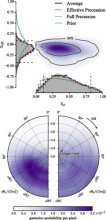
Abstract
We describe the observation of GW170104, a gravitational-wave signal produced by the coalescence of a pair of stellar-mass black holes. The signal was measured on January 4, 2017 at 10:11:58.6 UTC by the twin advanced detectors of the Laser Interferometer Gravitational-Wave Observatory during their second observing run, with a network signal-to-noise ratio of 13 and a false alarm rate less than 1 in 70,000 years. The inferred component black hole masses are 31.2+8.4−6.0M⊙ and 19.4+5.3−5.9M⊙ (at the 90% credible level). The black hole spins are best constrained through measurement of the effective inspiral spin parameter, a mass-weighted combination of the spin components perpendicular to the orbital plane, χeff=−0.12+0.21−0.30. This result implies that spin configurations with both component spins positively aligned with the orbital angular momentum are disfavored. The source luminosity distance is 880+450−390 Mpc corresponding to a redshift of z=0.18+0.08−0.07. We constrain the magnitude of modifications to the gravitational-wave dispersion relation and perform null tests of general relativity. Assuming that gravitons are dispersed in vacuum like massive particles, we bound the graviton mass to mg≤7.7×10−23 eV/c2. In all cases, we find that GW170104 is consistent with general relativity.